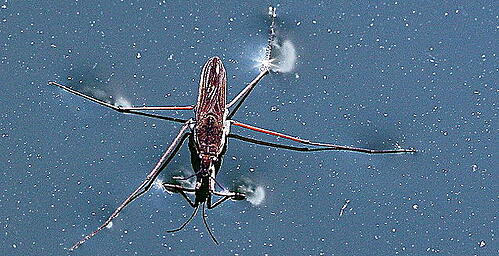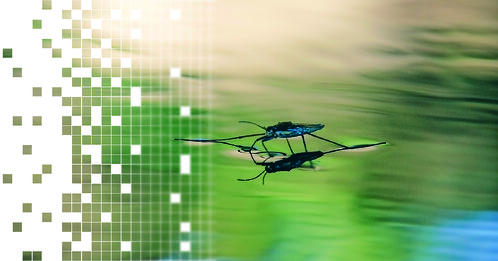A running theme in the Science Market Update is that nature seems to have all the answers to our bioscience questions, if only we know how to ask them. For instance, how do we make an anesthetic strong enough to make a scorpion sting painless? And what can we do to keep antibiotics from becoming ineffective? Today’s question, posed by researchers at Michigan State University, is: how can we quickly gather precise water pollution data over entire rivers and lakes? To which nature answers: send in a fleet of water striders.
Water striders are insects famous for their ability to dart across the surface of the water. They are commonly found in ponds and lakes but there are varieties that can glide across rivers and some that even brave the waves of the sea. Their secret is in their long, slender legs, which spread out across the water’s surface to spread out the mass of the already light bug. These legs are covered in hydrophobic hairpiles, which each appear to be the width of a human hair but are actually made up of hundreds of microhairs. This helps spread out the mass of each of the legs even further. As long as the strider keeps moving, their weight distribution will keep them just above the surface of the water.

(A water strider keeps skims along a pond, courtesy Wikimedia Commons and Hedwig Storch)
 Matt Mutka of MSU has been studying the unique body characteristics of the water strider and thinks the insect provides the perfect design for inexpensive water contaminant sensors. “The idea is to create very inexpensive, mobile sensors or small robots that can be quickly deployed, energy efficient and serve a large number of environmental monitoring applications,” he says in a MSU article. For instance, to immediately gather data on the direction and progression of an oil spill, Mutka proposes to simply drop his sensors in the water and let them skim around. "Once in the water, they will communicate with each other, consolidate their data samples and forward the samples to a receiver at the water's edge, which can forward to servers that further process the data." Together the striders paint a picture of where the oil is and where it’s going. Plus the striders can remain in the water to provide real-time updates.
Matt Mutka of MSU has been studying the unique body characteristics of the water strider and thinks the insect provides the perfect design for inexpensive water contaminant sensors. “The idea is to create very inexpensive, mobile sensors or small robots that can be quickly deployed, energy efficient and serve a large number of environmental monitoring applications,” he says in a MSU article. For instance, to immediately gather data on the direction and progression of an oil spill, Mutka proposes to simply drop his sensors in the water and let them skim around. "Once in the water, they will communicate with each other, consolidate their data samples and forward the samples to a receiver at the water's edge, which can forward to servers that further process the data." Together the striders paint a picture of where the oil is and where it’s going. Plus the striders can remain in the water to provide real-time updates.

(The new water-skimming sensor, courtesy MSU)
Mutka’s work is being funded by a $500,000 grant from the NSF. For more information on the grants MSU earns with its outstanding research, peruse our free Funding Statistics report, below:
Biotechnology Calendar, Inc. pays a visit to Michigan State University each year for the East Lansing BioResearch Product Faire™, a life science event held right on the university campus. Make sure to mark your calendar for July 23rd, 2014 when we next return to MSU. Biotechnology Calendar is a full service event company that has produced on-campus, life science research trade shows nationwide for the past 20 years. We plan and promote each event to bring the best products and services to the finest research campuses across the country. If you are a university researcher or a laboratory product vendor, consider attending one of our on-campus trade shows: here is our 2014 schedule.



